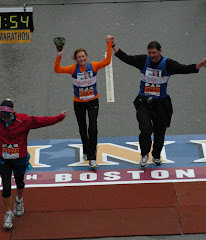Have I mentioned
I am blessed with 9 wonderful grandchildren?
The credit for that of course goes to their 6 loving parents (and I like
to believe a modicum of credit from us grandparents). Among the parents, all are athletes of
accomplishment, 4 have run marathons and 2 have run the Boston Marathon with
me. It’s no surprise that the 4 oldest grandchildren
are top runners on their school cross country team and the next youngest 2
while not old enough yet to join the school team, are also runners.
All of them
joined in to help me crank out the miles including the 3 and 5 year-olds who
ran/walked with me for a mile (actually they would sprint ahead then stop and
wait for me to catch up). I don’t have
words to express the joy of running with my grandkids, exchanging stories about
school, friends, activities and sports.
Equally emotional was having the family gather in Nick’s memory to help
children and their families struggling with cancer. Who wouldn’t tear up when the 3 and 5 year-olds
handed me their money from their Easter egg hunt to honor Nick and help the
sick children.
Another
Marathon Challenge in the books. We met
our family goal of 50 miles and God willing I will be out there again next
year. I am still in need of donations
to meet this years goals, if you haven’t given yet we can use your help.
As always,
thank you for your support.











